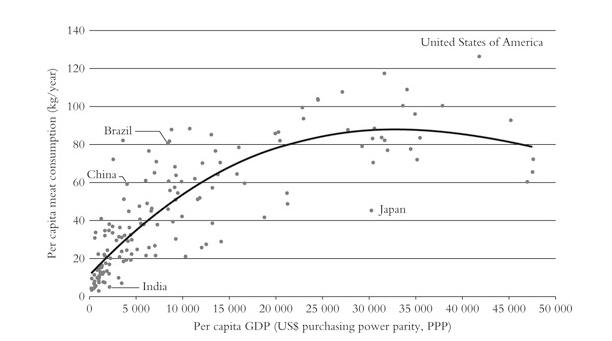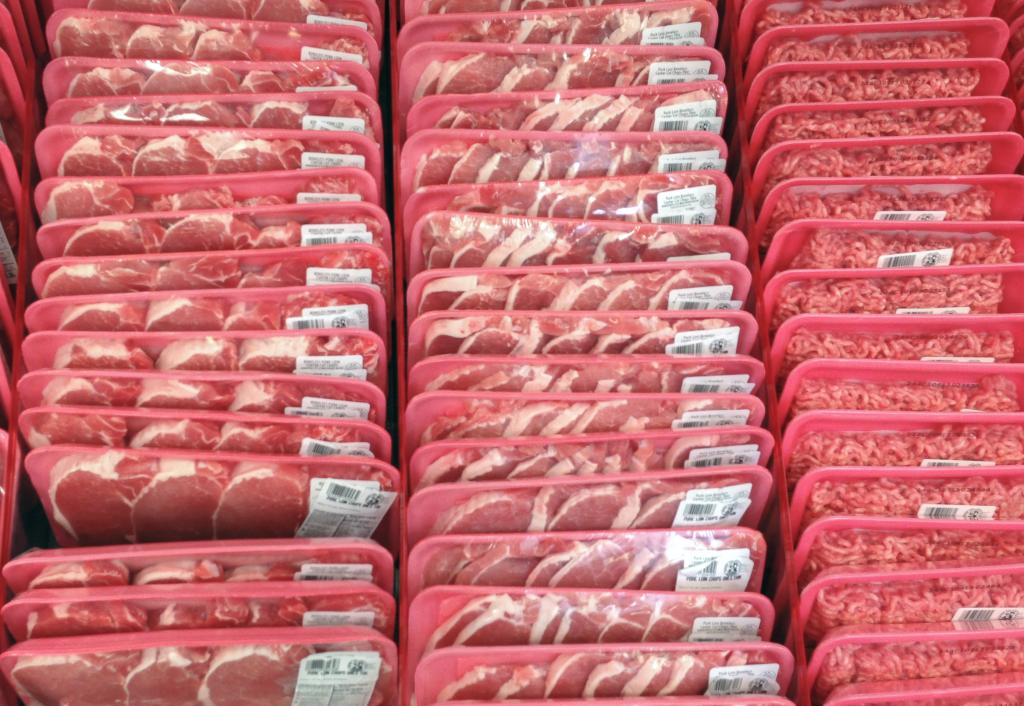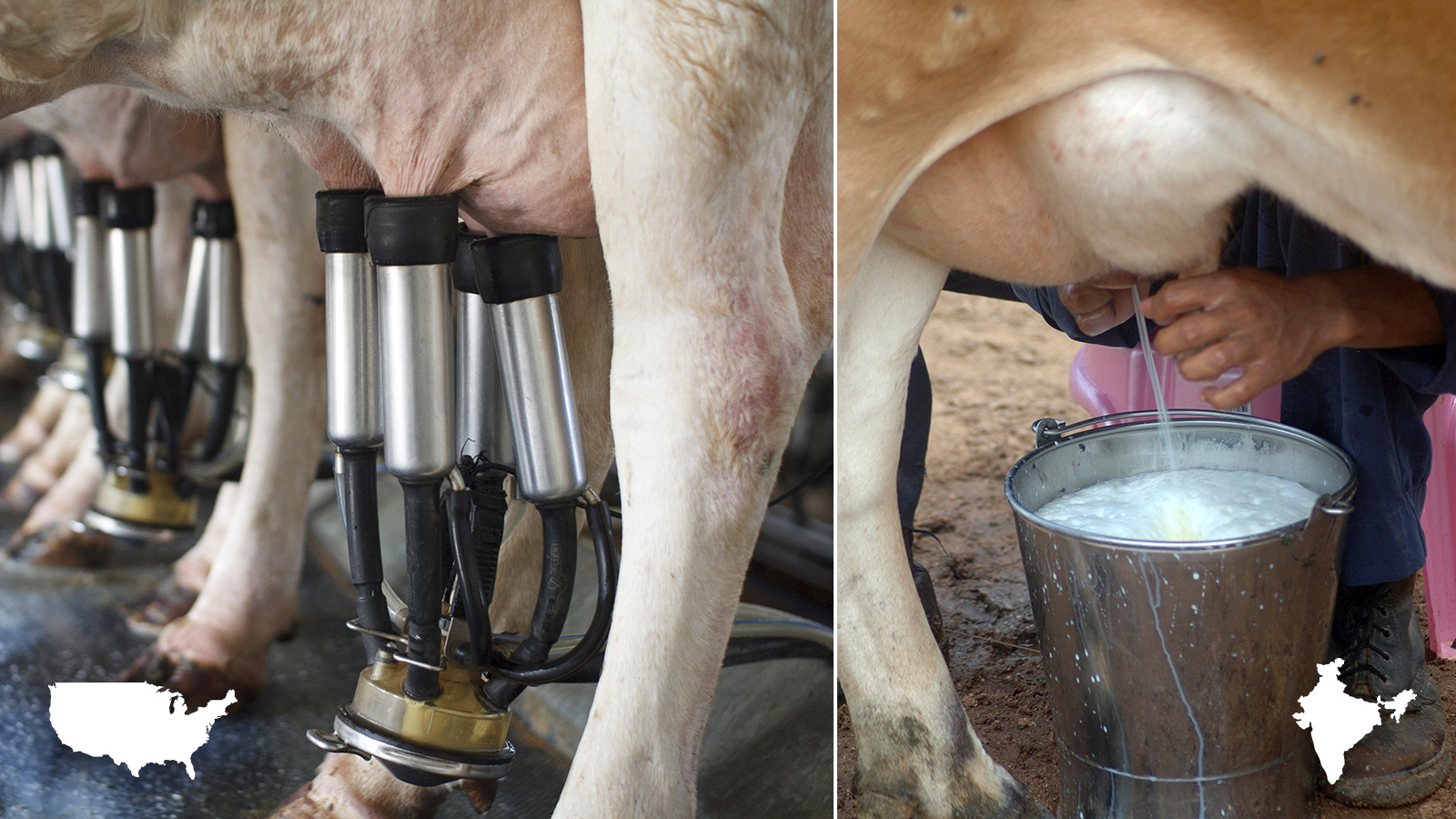We started out this series by asking if meat can be sustainable (yes, but we should eat less), and if meat can be moral (perhaps not, although that doesn’t seem to convince people to give it up). But no matter how we answer these questions, people around the world will continue to eat meat. In fact, meat consumption is increasing around the world as countries become wealthier.

U.N. Food and Agriculture Organization statistics as presented in One Billion Hungry: Can We Feed the World? by Gordon Conway
That leaves us with the practical meat question — that is, the question most likely to make a difference in practice: What’s the best way to produce all this meat?
When I put this to U.C. Davis animal scientist Frank Mitloehner, he gave me a simple answer: We should produce meat as efficiently as possible. Mitloehner is working on the United Nations project to assess the impact of livestock on the environment. (The last U.N. report on livestock was hugely influential, but also criticized for overestimating the climate impact of cattle).
Mitloehner helped hammer out precise rules for doing a full lifecycle assessment on the environmental footprint of animal products. And when he runs the numbers he gets the same answer over and over again: “What is directly linked to meat’s footprint is efficiency. When production per animal goes up, emissions go down. That has profound impacts,” he said. “Profound impacts.”
[grist-related-series]
Efficiency is often preceded by the word “ruthless,” because achieving it in one regard often means sacrificing everything else. Mitloehner is simply talking about producing more meat with less resources. But of course, if you take the pursuit of any kind of efficiency to its extreme, it can become ruthless efficiency — and different people have various opinions about where that line lies. (For more on that, here’s one animal welfare expert’s take on modern farming.) But in this piece, I want to focus tightly on the environmental impact of meat — and when you do that, it does make a lot of sense to try to produce more with less.
To show how this works, Mitloehner took the example of dairy cows. The average dairy cow in California produces 20,000 pounds of milk a year. But the average dairy cow in Mexico produces only 4,000 pounds of milk a year, while in India it’s just 1,000 pounds. The difference comes from better feed, better veterinary care, and better genetics. If Mexican and Indian cows were like California (bovine) girls, they would produce the same amount of milk with way fewer animals, which means way less climate impact.
As cattle geneticist Alison Van Eenennaam notes in Sustainable Animal Agriculture:
The US dairy cattle population peaked in 1944 at an estimated 25.6 million animals with a total annual milk production of approximately 53.1 billion kg. In 1997, dairy cattle numbers had declined to 9.2 million animals and total annual production was estimated at 70.8 billion kg.
We’ve gotten rid of more than half the dairy cows while increasing milk production by a third. This boggling accomplishment means that there are fewer cows producing less methane, while more Americans are pouring more milk over their cereal. The carbon footprint of American milk is 63 percent lower than in 1944, researchers have calculated. Nicolette Hahn Niman, in her book Defending Beef, crunched the numbers for the rest of the livestock in the U.S. and found evidence of a (more modest) overall decline: “[E]arly-20th-century farms and ranches had 76 million cattle and 164 million large animals, today they have 68 million cattle and 141 million large animals. In total, that’s a 14 percent reduction in large farm animals.”
Some of this reduction is the result of stock animals, which once supplied farmers with their main source of kinetic energy, being replaced by internal combustion engines. Take stock animals out of the equation and the numbers are basically flat. Still, that’s remarkable given that our meat consumption more than quintupled in that time.
All this provides some hope that the world could feed the rising middle class, with its hunger for meat, while also reducing the greenhouse gases produced by agriculture — especially if people in the richer countries cut their meat consumption. Unfortunately, that’s not what’s happening, said Ermais Kebreab, a scientist who studies greenhouse gas emissions from livestock. “The way things are going, developing countries basically have more and more animals with the same level of efficiency, and I think that’s not great for the environment, or for the producers,” he told me. “The best way to reduce greenhouse gas emissions and degradation of the environment is to improve efficiency. If they could have more efficient animals, the farmers would make more money.”
Some improvements are distinctly low tech. It makes a huge difference when farmers simply keep the animals with the most desirable characteristics for breeding, rather than selling them, Van Eenennaam said. But when farmers are very poor, they often have little choice but to sell the animals that will bring in the highest price: “They sell the big ones and keep the little ones for their breeding stock,” she said. It’s just the opposite of what you’d want.
Kebreab, who has worked the last five years with small farmers in Vietnam, found that farmers could significantly reduce their emissions and improve efficiency with a few simple changes. For instance, farmers often end up with too much rice straw, which they burn, he said. By treating that straw with urea, they can make it digestible for ruminants, he said.
Another simple way to improve efficiency is to supplement ruminant feed with a little grain at key points in the animal’s life, like during pregnancy, Kebreab said. When a cow is eating grass, about 7 percent of the energy from that feed turns into methane, but on a feedlot, only 3 percent of the feed energy turns into methane — the rest goes into meat or milk.
This may require a bit more explanation, since we generally think of grass feeding as the preferred system. It’s clearly greener, in terms of land use, to have ruminants only eating grasses, or residues (like rice straw), that don’t compete with human food crops. But it’s also clear that cattle produce more greenhouse gases — and grow more slowly — when eating only grass. Giving cattle grain for a few months is a good environmental choice, Mitloehner told me.
“All but a small percentage of beef cattle are on pasture most of their lives, then fattened up on a feedlot for the last four months on average,” he said. “On grass it takes them 26 to 30 months to reach market weight. On feedlots it takes 14 to 15 months, [10 months on grass and] the last four months on a diet of 80 to 90 percent corn.”
There are greenhouse gas emissions associated with growing and transporting that corn, but those are typically smaller than the emissions that come from a steer eating grass and burping up methane for an additional 10 months.
Another relatively low-tech way to make meat production more efficient would be to farm more fish — if we include fish in the definition of meat. Fish are just incredibly efficient. Because they are cold-blooded and buoyant in the water, they don’t burn energy generating heat and fighting gravity to move around. (For greater — oceanic! — depth on the potential of fish farming, see Amelia Urry’s piece in this series.)
Every expert I talked to said that higher-tech improvements would also make a huge difference in decreasing the environmental impacts of meat. As long as we are talking about fish farming, we should note that a genetically engineered salmon can produce a pound of fish for every .83 pounds of feed it eats — which seems to violate the second law of thermodynamics. (It doesn’t, because the meat includes water weight — that’s standard for calculating feed conversion ratios — still, it’s amazing relative to other ratios.)
When I asked Van Eenaaman where we might find low-hanging fruit, she suggested working on disease resistance. “We lose 20 percent of animal protein to disease,” she said. “I think genetics is the best way to work on that because once you have the disease resistance in there it’s inherited and it’s free to the offspring.”
Improving disease resistance could be accomplished through conventional breeding or gene editing, and it would have several benefits, Van Eenaaman said. “You’re not treating them with antibiotics, they are healthier, so welfare improves, you aren’t spending money on treatment, and you improve efficiency.”
One of Kebreab’s favorite high-tech solutions is a genetically engineered pig. Pigs are terribly inefficient in the way that they absorb phosphorus, he explained. When plants take up phosphorus, they lock it in a sort of molecular safe — phytic acid. Unlike ruminant animals, pigs do not produce the enzyme phytase — the key that unlocks this safe. This creates problems on both ends: Pigs just keep eating until they are able to extract enough phosphorus from the grains; and you can only apply so much pig manure to a field before you overload the land with phosphorus. In China, which already has half the world’s pigs and a growing appetite for pork, people are desperate to find a solution to phosphorus pollution, he said. And at the same time that hog country is saturated with the stuff, the world is running out of phosphorus.
“Phosphorus is a finite resource — when it’s done, it’s done,” Kebreab said. “Right now pigs utilize 30 to 40 percent at most of the phosphorus in feed, and then the rest would be excreted. We have genetically engineered pigs that produce the phytase enzyme — they utilize 80 percent of the phosphorus.”
But, he said, scientists are worried about the reaction to genetically modified animals, and the industry worries that eaters will find GM animals less appetizing than GM crops.
“That’s what frustrates some of us,” he said. “There is a solution for an environmental problem, but we aren’t using it.”
When I asked Kebreab if he had a vision for the future of animal agriculture, he also came up with something that might either be low-tech or high-tech, depending on how you look at it. “We need diversity,” he said. “The environment, it’s quite different in different places. For instance, dairy cattle need about 15 degrees Celsius — that’s their thermoneutral zone — and if you have them in hot and humid areas they’re not going to do well. To me it doesn’t make sense to have animals in environments where they are not suited. Instead, specialize in different areas — working with nature instead of trying to change nature all the time.”
“Interesting,” I said. “So in that case, working with nature means more international trade?”
“Yeah,” he replied. “That could be a solution for sure.”
All of this was a bit of a mind-bender for me. Just as it was counter-intuitive to think of grass-fed beef being more carbon intensive than grain-finished beef, I’m used to thinking of local food being greener than the kind shipped from another climate. But every scientist I talked to assured me that the carbon costs of producing meat inefficiently usually outweigh the carbon cost of transportation. “The way these demands can be met is through higher efficiency,” Mitloehner said. “I don’t think there is any other way.”
Of course, the other way is to not meet the demand for meat. Some people have talked about the idea of taxing meat to squelch the demand, but that’s still just a concept, and even if a meat tax passed (probably in some wealthy country) it would probably only make a small blip in the worldwide consumption trends. As long as people continue to farm animals and eat meat, it makes environmental sense to produce that meat as efficiently as possible.
It may not make sense in other ways: Feedlots are a lot less aesthetically pleasing than grasslands. Once we expand the field of view from a narrow focus on the environment, we might want to trade efficient production for better animal welfare, or a farming system that empowers the little guys, or farms that improve the view rather than spoiling it.
The researchers I talked to were focused on what could be done on a grand scale, affecting the entire world. But there are small-scale examples of people producing meat in a way that seems to balance out all those things nicely. I liked the look of Paul Willis’ pig farm when I visited it — this Niman Ranch operation isn’t as efficient as most modern hog farms, but it’s certainly a lot prettier. And celebrity farmer Joel Salatin is every journalist’s favorite proof that it’s possible to produce a lot of meat on a small amount of land. I bet if anyone ever did a full scientific assessment of all Salatin’s environmental impacts he’d come out looking pretty good.
Small scale, intensively produced meat might be the best choice for people who can afford it. But there are billions of people who can’t afford it, or just don’t care, and they’re buying more meat every year. That hungry majority is going to buy meat, whether it’s environmentally friendly or not. Increasing the productivity of animal agriculture, especially in the poorest parts of the world, will do a lot to reduce the impact of all the meat eating, while also rewarding farmers.



